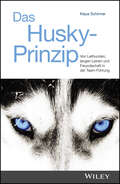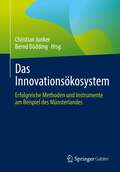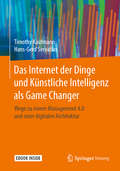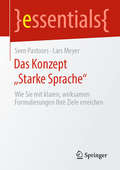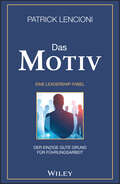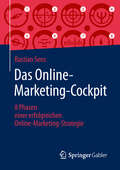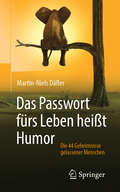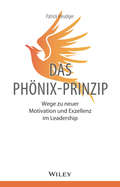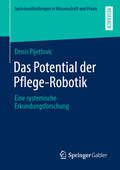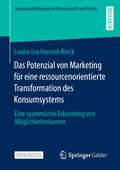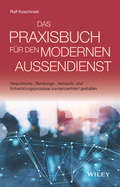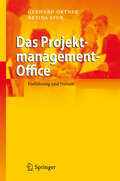- Table View
- List View
Das Husky-Prinzip: Von Leithunden, langen Leinen und Freundschaft in der Team-Führung
by Klaus SchirmerWer als guter Mitarbeiter volle Leistung bringen will, der muss "von oben", also von der Führung her, die Möglichkeit erhalten, weitgehend frei, unabhängig und situativ entscheiden zu können. Für eine solche Freiheit muss im gesamten Unternehmen - oder zumindest innerhalb der Abteilung - Vertrauen herrschen. Es braucht eine freundschaftliche Unternehmenskultur. Genau hier setzt Klaus Schirmer in seinem Buch an. Es basiert auf dem Ansatz "Führung nach dem Prinzip der Freundschaft". Der Autor bedient sich für den Handlungsablauf des "Husky-Prinzips", wobei die spezielle Beziehung zwischen Schlittenhunden und ihrem menschlichen Führer, dem "Musher", als Metapher herangezogen wird und aufzeigt, was "Führen mit langer Leine und auf freundschaftlicher Basis" alles an positiven Elementen und Ergebnissen im unternehmerischen Umfeld bewirken kann, ohne dabei Disziplin oder Ergebnisorientierung zu vergessen. Die Mitarbeiter befinden sich in einem Team des Vertrauens, dem "Husky-Team". Sie stehen wie ein erprobtes Husky-Schlitten-Gespann zueinander, sind ein eingespieltes Team, können sich aufeinander verlassen und tragen und entlasten sich, wann immer es erforderlich ist. "Das Husky-Prinzip" liefert Führungskräften auf allen Ebenen nachweislich wirksame und vom Autor selbst erprobte und in die Praxis umgesetzte Bausteine und Instrumente, die jede Organisation dabei unterstützen können, die immer höher werdende Komplexität der Mitarbeiterführung und Mitarbeiterbindung auf der Basis eines neuen, freundschaftlichen, vertrauensvollen Ansatzes zu meistern.
Das Ideenmanagement als Geschäftsmodell (BestMasters)
by Finn ReicheDas Ideenmanagement ist ein ganzheitlicher Ansatz für Firmen, die Ideen und Verbesserungsvorschläge ihrer Mitarbeitenden als Potenzial zu Innovation und Verbesserung zu nutzen. Hierbei sind Faktoren wie die richtige Ausgestaltung des Ideenmanagements als auf die Mitarbeitenden ausgerichtetes Ideenmanagement-System ebenso wichtig wie die Kundenzentrierung, um ein "lebendes System" mit ausreichend Ideen und Verbesserungsvorschlägen zu kreieren. Das Ideenmanagement wird dabei meist prozessual betrachtet. Im vorliegenden Beitrag wird es als zu anderen bestehenden Konzepten wie dem Kontinuierlichen Verbesserungsprozess oder dem Innovationsmanagement abgegrenzt, als Geschäftsmodell untersucht sowie die Erfolgsfaktoren herausgearbeitet. Es wird eine Nutzer- und Kundenzentrierung vorgeschlagen sowie Ergebnisse einer breiten Umfrage bezüglich der Erfolgsfaktoren präsentiert als auch eine Herangehensweise für die Etablierung des Ideenmanagements als Geschäftsmodell vorgeschlagen.
Das Innovationsökosystem: Erfolgreiche Methoden und Instrumente am Beispiel des Münsterlandes
by Christian Junker Bernd BüddingDas Buch zeigt am Beispiel der mittelständisch geprägten Region des Münsterlands auf, wie sich das komplexe Feld regionaler Innovationsförderung theoretisch und praktisch erfassen lässt. Die Autoren beschreiben die Ergebnisse und Erkenntnisse aus dem Projekt Enabling Innovation Münsterland, einem Verbundprojekt unter Leitung des Münsterland e.V. mit acht beteiligten Partnerorganisationen aus der regionalen Technologie- und Wirtschaftsförderung und den regionalen Hochschulen. Die Einschätzungen und Erfahrungsberichte werden anschaulich und praxisnah vorgestellt, um die im Projekt erarbeiteten Ergebnisse anderen Regionen mit ähnlichen Strukturen und (v.a. mittelständischen) Unternehmen, Hochschulen und Wirtschaftsförderungen zur Verfügung zu stellen. Es werden zahlreiche Best Practices für Methoden und Instrumente vorgestellt mit dem Ziel, die regionale Innovationsentwicklung voranzutreiben und den „Entrepreneurial Spirit“ auf die Herausforderungen der Gegenwart auszurichten.
Das Internet der Dinge und Künstliche Intelligenz als Game Changer: Wege zu einem Management 4.0 und einer digitalen Architektur
by Timothy Kaufmann Hans-Gerd ServatiusDas Internet der Dinge (IoT) und Künstliche Intelligenz (KI) bieten im Zuge der Digitalisierung große Chancen für innovative Geschäftsmodelle und Produktivitätssteigerungen von Unternehmen. Diese Chancen nutzen gegenwärtig vor allem die großen Digital-Champions und Startups. Umfassend und aktuell greifen die Autoren diese Herausforderung für etablierte Unternehmen auf. Zentrale These des Buches ist, dass diese digitalen Technologien die Spielregeln des Wettbewerbs grundlegend verändern und zu Game Changern werden. Die Autoren belegen dies in vier Blöcken: Im ersten Teil erläutern sie wichtige Begriffe. Im zweiten Teil beschreiben Timothy Kaufmann und Hans-Gerd Servatius die Entwicklung zum neuen Management 4.0-Paradigma und dessen Bausteine. Der dritte Teil beschäftigt sich mit dem Wandel der Informations- und Kommunikationstechnik hin zu einer durch IoT- und KI-Technologien geprägten digitalen Architektur. Der abschließende vierte Teil skizziert die Bausteine einer Innovationspolitik 4.0 für den digitalen Wandel, die den Rahmen für Management- und Architektur-Innovationen liefert.Dank klarer Gliederung, anschaulicher Erläuterung der neuen Konzepte und zahlreicher Beispiele aus der Praxis ist das Buch eine wichtige Orientierungshilfe für alle, die nach erfolgreichen Wegen zu einem Management 4.0 und einer digitalen Architektur suchen.
Das Kommunikationskonzept: Einführung in die Entwicklung von Kommunikationskonzepten – In zehn Schritten zum Erfolg (essentials)
by Christoph BlankDieses essential bietet komprimiertes Wissen für alle, die Kommunikationskonzepte entwickeln, bewerten und umsetzen möchten. Dies ist weder Hexenwerk, noch nur etwas für kreative Köpfe. Der Prozess ist weitgehend standardisiert und folgt einer festen Struktur. Die in diesem Buch vorgestellte Vorgehensweise deckt in zehn Schritten alle entscheidenden analytischen, strategischen und operativen Aspekte ab, die kompakt und auf den Punkt beschrieben werden – mit dem Ziel eines umsetzungstauglichen Konzeptes für die Praxis. Hinweise zu weiterführender Literatur und nützlichen Tools bieten die Möglichkeit der Wissensvertiefung.
Das Konzept „Starke Sprache“: Wie Sie mit klaren, wirksamen Formulierungen Ihre Ziele erreichen (essentials)
by Sven Pastoors Lars MeyerWer etwas Interessantes zu sagen hat, dem hören sowohl Kunden als auch Kollegen gerne zu. Die Art und Weise, wie wir kommunizieren, ist somit entscheidend für unseren beruflichen und privaten Weg. Zudem hängt das Maß, wie kompetent und glaubwürdig uns unsere Gesprächspartner einschätzen, maßgeblich vom Gebrauch unserer Sprache ab. In sechs Kapiteln vermitteln die Autoren in diesem essential ihren Lesern die Grundlagen starker, wirksamer Sprache. Der Fokus liegt dabei auf einer klaren und deutlichen Ausdrucksweise. Dies ist eine wichtige Voraussetzung für erfolgreiches Kommunizieren, Verhandeln und Diskutieren.
Das Landkartenmodell – der Schlüssel für erfolgreiche Veränderungen: Eine Entscheidungshilfe für das mittlere Management (essentials)
by Sven GuggenheimDieses essential zeigt, wie jeder Leader aus dem mittleren Management sein individuelles Landkartenmodell in drei einfachen Schritten designen kann. Es ist für diejenigen, die die Notwendigkeit von Veränderungen in der eigenen Firma erkannt haben und ihre Zukunft mitgestalten, oder anders ausgedrückt, «designen» möchten. Für diejenigen, die Veränderung als Teil der heutigen Welt sehen und nicht nur als ein «Projekt» - für das mittlere Management mit dem Mindset des strategischen Designs.
Das Leistungsspektrum von Coaching: "Was" es kann und "wie" es erfolgreich gelingt
by Winfried ProstDieses Buch vermittelt anschaulich in elf fundierten Beitr#65533;gen erfahrener Coaches die Bandbreite der erfolgreichen Coachingarbeit. Coaches sind Diagnostiker. Sie untersuchen Lebenssituationen, Handlungsstrategien, Verhaltensmuster und werden konsultiert, wenn irgendetwas nicht so l#65533;uft wie erw#65533;nscht. Ganzheitlich arbeiten bedeutet dann, den #65533;berblick zu gewinnen und L#65533;sungen zu finden. Dabei k#65533;nnen Coaches technisch genauso exakt vorgehen wie ein Mechaniker oder Chirurg. Dieses Buch berichtet von den psychologischen Methoden, die sich in vielen F#65533;llen bew#65533;hrt haben. Eine spannende Lekt#65533;re mit vielen konkreten Tipps f#65533;r Coaches wie auch f#65533;r Klienten.
Das Lieferkettensorgfaltspflichtengesetz: Gesetzesanforderungen, Umsetzung und Fortentwicklungsbedarf in der Textilbranche (BestMasters)
by Lena Sofie StörkDas LkSG kodifiziert erstmalig Lieferkettensorgfaltspflichten für deutsche Unternehmen und begründet somit einen Paradigmenwechsel von bislang freiwilliger verantwortungsvoller Unternehmensführung hin zu Verbindlichkeit hinsichtlich Umwelt- und Menschenrechtssorgfalt. Die Neuartigkeit des Regelungskontextes sowie erhebliche Negativfolgen bei Non-Compliance resultieren in großen Herausforderungen bei der Umsetzung der Vorgaben. Medienwirksame Menschenrechtskatastrophen haben in diesem Zusammenhang die gesellschaftliche Sensibilisierung für menschenrechtliche Auswirkungen in den international verflochtenen und hochrisikobehafteten textilen Lieferketten deutlich erhöht. Vor diesem Hintergrund erfolgt eine ausführliche Darstellung der Rechtsgrundlagen, komplexen Regelungsinhalte und ökonomischen Implikationen des Gesetzes. Außerdem bietet das Buch eine praktische Orientierungshilfe zur Umsetzung des LkSG. So erfolgt eine exemplarische Risikoanalyse, welche die im Gesetz definierten geschützten Rechtsgüter und Anforderungen praxisnah illustriert. Anhand der Herleitung eines konkreten Risikobewertungsframeworks sowie spezifischer Umsetzungsinstrumente zur Maßnahmenwirksamkeitsmessung werden weitere konkrete Handlungsempfehlungen abgeleitet. Das Buch empfiehlt schließlich die integrierte Steuerung der Sorgfaltspflichten anhand etablierter Managementinstrumente des Compliance- und Risikomanagements zur handlungssicheren und effizienten Umsetzung der Gesetzesanforderungen.
Das Machiavelli-Syndrom: Krankheitssymptome des Unternehmens — Diagnose, Therapie, Prävention
by Wilhelm R. WolfDer Fortschritt in der Kommunikationstechnik erlaubt es, auch sehr komplexe Informationsstrukturen ohne regionale und zeitliche Limitierung zu verbreiten, was eine schnelle, optimale globalstrategische Nutzung aller verfügbaren Ressourcen möglich macht. Die hierdurch hervorgerufenen strukturellen Veränderungen in der Weltwirtschaft sind weder aufzuhalten noch umkehrbar. Dies führt zwangsläufig zu langfristigen weltweiten Umschichtungen und Umverteilungen von Märkten, Machtbefugnissen, Arbeitsteilungen, Einkommen und Vermögenswerten. Parallel dazu führen große Unterschiede der Lebensumstände in den unterschiedlichen Regionen dieser Welt zu starken Wanderungsbewegungen von Arbeitsuchenden und Flüchtlingen. Der Umstrukturierungsprozess der Weltwirtschaft, der hierdurch in Gang gesetzt wird, erfolgt in einem Umfang und mit einer Geschwindigkeit, der große Anforderungen an die Flexibilität, Leistungsbereitschaft und Leistungsfähigkeit aller betroffenen Volkswirtschaften, der in ihnen tätigen Unternehmen und damit an uns alle stellt. Diesen Umstrukturierungsprozess möglichst reibungsfrei, ohne Aggressivität in wirtschaftlicher, politischer und auch militärischer Hinsicht zustande zu bringen, ihn friedlich, als Evolution und nicht als Revolution zu verstehen und zu managen, das ist die Aufgabe unserer Zeit. Rudolf R. Wolf nimmt ihn nach der 1. Auflage von 1996 ein zweites Mal in den Blick.
Das Management-Handbuch für Chief Data Officer: Aufbau und Betrieb der Daten-Supply Chain eines Unternehmens
by Martin TrederEs lässt sich nicht leugnen, dass das 21. Jahrhundert datengesteuert ist, wobei viele digitale Branchen auf die sorgfältige Erfassung und Analyse großer Mengen von Informationen angewiesen sind. Ein Chief Data Officer (CDO) in einem Unternehmen ist der Leiter dieses Prozesses, was diese Position oft zu einer Herausforderung macht. Das Chief Data Officer Management Handbook soll hier Abhilfe schaffen.In diesem Buch gibt der Autor Martin Treder Ratschläge, wie CDOs besser auf ihren Verantwortungsbereich vorbereitet werden können, wie sie einen nachhaltigeren Ansatz entwickeln und wie sie die typischen Fallstricke vermeiden können. Basierend auf den positiven und negativen Erfahrungen aktueller CDOs hilft das Chief Data Officer Management Handbook dabei, die ideale Struktur eines Datenbüros zu entwerfen, sie zu implementieren und die richtigen Leute an Bord zu holen.Wichtige Themen wie die Datenversorgungskette, die Datenstrategie und die Data Governance werden von Treder sorgfältig behandelt. Als CDO ist es wichtig, dass Sie Ihre Position mit Ihrem gesamten Team effektiv nutzen. Das Chief Data Officer Management Handbook ermöglicht es allen Mitarbeitern, die Verantwortung für die Zusammenarbeit im Bereich Daten zu übernehmen. Daten sind die Grundlage heutiger und zukünftiger technologischer Innovationen, und Sie könnten die Führungspersönlichkeit sein, die die nächste große Veränderung bewirkt.Was Sie lernen werden:Wichtige Elemente eines effektiven Datenmanagements anwendenSie erhalten einen umfassenden Überblick über alle Datenbereiche (die oft unabhängig voneinander verwaltet werden) Arbeiten Sie mit der Datenversorgungskette, von der Datenerfassung bis zur Datennutzung, einer Überprüfung aller relevanten Interessengruppen, der Datenstrategie und der DatenverwaltungFür wen ist dieses Buch gedacht?CDOs, Datenverantwortliche, Datenberater und alle Fachleute, die verstehen wollen, wie ein Datenbüro in einer Organisation funktioniert.
Das Motiv: Der einzige gute Grund für Führungsarbeit - eine Leadership-Fabel
by Patrick M. LencioniShay war zwar immer noch wütend, zuckte aber mit den Schultern, wie um zu sagen, dass es schon okay wäre. "Und womit habe ich unrecht?" "Das werden Sie zwar nicht hören wollen, aber ich muss es Ihnen trotzdem sagen." Liam machte eine kurze Pause, bevor er fortfuhr. "Mag ja sein, dass Sie hier bis zum Umfallen arbeiten. Aber Sie tun das nicht im Sinne des Unternehmens." "Was zum Teufel soll denn das jetzt heißen?", wollte Shay wissen. Auch wenn er fürchtete, dass sein Gegenüber gleich handgreiflich werden könnte, antwortete Liam: "Sie tun das alles nur für sich selbst." Der Bestsellerautor Patrick Lencioni hat ein Dutzend Bücher geschrieben, die sich darauf konzentrieren, wie Führungskräfte Teams und Führungsorganisationen aufbauen können. In "Das Motiv" verlagert er seine Aufmerksamkeit darauf, ihnen zu helfen, die Bedeutung des Beweggrunds zu verstehen, warum sie überhaupt in einer Führungsrolle sind. In seiner vielleicht bisher überzeugendsten Fabel stellt Lencioni zwei neue Charaktere vor, Shay Davis und Liam Alcott, konkurrierende Geschäftsführer zweier sehr unterschiedlicher Unternehmen in derselben Branche. Shay Davis ist der CEO von Golden Gate Security, der sich nach nur einem Jahr in seiner Funktion Sorgen um seinen Job macht und verzweifelt herausfinden will, wie man die Dinge in den Griff bekommt. Er erhält von der unwahrscheinlichsten und unerwünschtesten Quelle - Liam Alcott, CEO eines erfolgreicheren Sicherheitsunternehmens und sein verhasstester Gegner - einige schwer zu beschönigende Ratschläge. Lencioni nimmt uns durch unerwartete Twists und einen knackigen Dialog mit auf eine Reise, die in einer ebenso unerwarteten wie erhellenden Lösung gipfelt. Über die fiktive Geschichte hinaus bietet er eine einfache Zusammenfassung der Lektionen aus der Fabel und kombiniert eine klare Erklärung seiner Theorie mit praktischen Ratschlägen, um Führungskräften zu helfen, ihre wahre Motivation zum Führen zu untersuchen. Lencioni fordert die Leser nicht nur auf, sich selbst ehrlich zu beurteilen, sondern präsentiert auch Handlungsschritte zur Änderung ihres Ansatzes in fünf Schlüsselbereichen. Auf diese Weise hilft er den Führungskräften, die Fallstricke zu vermeiden, die sie aus der Bahn werfen und sogar die Menschen verletzen, denen sie dienen sollen.
Das Muster-essential: Ein Überblick für Autor*innen (essentials)
by Angela MeffertEssentials vermitteln Wissen in kompakter Form anhand kleiner, komprimierter Wissensbausteine. Damit ergänzen sie die klassischen Lehr- und Fachbücher und großen Handbücher von Springer um ein neues Buchformat von ca. 30 bis 40 Seiten, das sich besonders für die Nutzung auf modernen Tablet-PCs und E-Book-Readern eignet.Mit diesem essential stellen wir Ihnen diesen Buchtyp vor: Auf wenigen Seiten erhalten Sie einen kompakten Überblick darüber, was ein essential auszeichnet, wie es aussieht und auf welche Punkte beim Aufbau zu achten ist.In der 2. Auflage wurde das Muster-essential aktualisiert.
Das Natural-Leadership-Prinzip: Mit bewusster Selbstführung zur Führungspersönlichkeit
by Anja NiekerkenWas macht eigentlich gute Führung aus? Stellt man diese Frage verschiedenen Menschen, gibt es darauf oft keine eindeutige Antwort. In den meisten Fällen haben die Befragten ein paar Vorbilder im Kopf. Aber warum gerade diese gute Führungskräfte sind oder waren, kann kaum jemand beantworten. Warum gute, charismatische Führung so schwer zu greifen ist, liegt vor allem daran, dass es dabei nicht um andere geht, sondern um sich selbst. Ein Widerspruch in sich? Im Gegenteil! Denn nur, wer sich selbst kennt, kann sich selbst führen. Und nur, wer sich selbst führen kann, kann andere mitnehmen. Aber sich selbst zu kennen, bedeutet nicht nur die eigenen Vorlieben und ein paar Schwächen zu kennen, sondern auch mit den eigenen Denkfehlern in Einklang zu sein. Das Natural-Leadership-Prinzip geht den Komponenten der Selbstführung auf den Grund und zeigt, wie man mit ehrlicher, konsequenter Selbstführung von der Führungskraft zur Führungspersönlichkeit wird. Ein Weg zur tieferen Selbsterkenntnis, zum selbstverständlichen Führen und zu einem bewussteren Leben.
Das Online-Marketing-Cockpit: 8 Phasen Einer Erfolgreichen Online-marketing-strategie
by Bastian SensErstellen Sie mit diesem Buch Ihre eigene Online-Marketing-StrategieNutzen Sie dieses Buch über Online-Marketing, um Ihr eigenes Online-Marketing-Konzept zu erstellen und so alle für Sie relevanten Plattformen zu identifizieren und zu bedienen. Diese Fachlektüre erläutert Ihnen acht Phasen, in denen Sie Ihre eigene Online-Marketing-Strategie erstellen und diese in Ihrem Unternehmen umsetzen können. Dabei legt das Buch auch ein Augenmerk auf das immer wichtiger werdende Thema des Bewerbermarketings. Viele Unternehmen haben im Bereich Online-Marketing Nachholbedarf, weil sie nicht wissen, welche Plattformen für sie geeignet sind oder wie und welche Inhalte sie konzipieren können. In mehreren Schritten zeigt der Autor dem Leser den Weg zur eigenen Online-Marketing-Strategie. Er geht dabei wie folgt vor:In einer kurzen Einleitung erklärt Bastian Sens, weshalb Unternehmen ein Cockpit für das Online-Marketing benötigen.Eine Faktorenanalyse zeigt, was Unternehmen bei ihrer Strategie beachten sollten.Anschließend beschreibt das Online-Marketing-Buch acht Phasen, in denen eine eigene Online-Marketing-Strategie erstellt werden kann.Praktische Tipps helfen dabei, das erarbeitete Konzept umzusetzen. Acht Phasen zur Erstellung des Online-Marketing-KonzeptsMithilfe einer Schritt-für-Schritt-Anleitung kann der Leser seine persönliche Online-Marketing-Strategie erstellen. Dabei werden die folgenden Phasen durchlaufen:PositionierungZielgruppenbestimmungZielsetzungKanal- und Instrumentenauswahl, darunter SEO, Google Adwords und Social-Media-PortaleContenterstellungConversion-OptimierungControllingAutomatisierungMit seinen praktischen Tipps ist dieses Buch nicht nur hilfreich für Webagenturen, sondern Pflichtlektüre für alle Marketingleiter und Unternehmer, die ihren Betrieb in Sachen Online-Marketing voranbringen möchten.
Das Passwort fürs Leben heißt Humor
by Martin-Niels DäflerMit vielen Praxisbeispielen und klar strukturiert beschreibt Däfler, was gelassene Menschen anders machen. Er begibt sich auf die Suche nach den Geheimnissen gelassener Menschen. In ICEs, Fitnessstudios und Restaurants sieht er sich ebenso um wie in der Literatur. Nach und nach offenbaren sich ihm 44 Geheimnisse, die er schließlich zusammenfasst, ordnet und in diesem Buch vorlegt. So unverkrampft und witzig, gleichzeitig jedoch auch fundiert, hat noch niemand über Gelassenheit geschrieben.Als erfahrener Trainer, Redner und Coach ist Däfler deutschlandweit gefragter Experte bei den Themen Stressabbau, Resilienz und Burn-out-Prophylaxe. Zahlreiche Bücher, Interviews und Vorträge haben ihn zu einem der bekanntesten Fachleute in diesem Genre gemacht.
Das Passwort fürs Leben heißt Humor: Die 44 Geheimnisse gelassener Menschen
by Martin-Niels DäflerMit vielen Praxisbeispielen und klar strukturiert beschreibt Däfler, was gelassene Menschen anders machen. Er begibt sich auf die Suche nach den Geheimnissen gelassener Menschen. In ICEs, Fitnessstudios und Restaurants sieht er sich ebenso um wie in der Literatur. Nach und nach offenbaren sich ihm 44 Geheimnisse, die er schließlich zusammenfasst, ordnet und in diesem Buch vorlegt. So unverkrampft und witzig, gleichzeitig jedoch auch fundiert, hat noch niemand über Gelassenheit geschrieben. In der zweiten Auflage geht der Autor auch auf die tiefgreifenden Folgen der Coronakrise ein.Als erfahrener Trainer, Redner und Coach ist Däfler deutschlandweit gefragter Experte bei den Themen Stressabbau, Resilienz und Burn-out-Prophylaxe. Zahlreiche Bücher, Interviews und Vorträge haben ihn zu einem der bekanntesten Fachleute in diesem Genre gemacht.
Das Persona-Prinzip: Erfolgreiches Recruiting mit Candidate Personas
by Stefan RipplerFachkräftemangel, Digitalisierung und sich ständig ändernde Bedürfnisse wie Anforderungen der Bewerbenden: Erfolgreiches Recruiting rückt konsequent die Jobsuchenden in den Fokus. Mit dem Persona-Prinzip gelingt das. Prototypische Zielgruppenvertreter schaffen ein besseres Verständnis der Bewerbenden und helfen bei zielgerichtetem Marketing und auf den Punkt formulierten Stellenanzeigen. Candidate Personas machen Customer-Centricity im Recruiting möglich und erleichtern damit die Personalsuche. Was Kundenzentriertheit im Recruiting bedeutet, woher der Begriff kommt, was Candidate Personas sind, warum sie datenbasiert sein müssen und wie Sie sie selbst erstellen, das verrät dieser praxisnahe Ratgeber mit Beispielen und sofort anwendbaren Checklisten.
Das Personal in der Weiterbildung: Im Spannungsfeld von Professionsanspruch und Beschäftigungsrealität
by Rolf Dobischat Anna Rosendahl Arne EliasDer Band thematisiert Entwicklung, Stand und Folgen der Besch#65533;ftigungsbedingungen, der Professionalisierung und der Professionalit#65533;t des Weiterbildungspersonals. Untersucht und kritisch analysiert werden die Interdependenzen dieser Facetten aus der Perspektive von Wissenschaft, Praxis und interessenpolitischen Akteuren.
Das Phönix-Prinzip: Wege zu neuer Motivation und Exzellenz im Leadership
by Patrick FreudigerIst "Chefsein" überhaupt noch erstrebenswert? Patrick Freudiger sagt: Ja! Denn die simple Tatsache, dass das Verhalten des Chefs die geführten Mitarbeiter zu Höchstleistungen anspornen aber auch zu einer demotivierten Arbeitshaltung führen kann, hat nach wie vor Gültigkeit. Dennoch fühlen sich manche Chefs ausgebrannt, unmotiviert und fragen sich, ob sie wirklich noch weiter als Führungskraft tätig sein wollen. Hier tut es Not, sein Führungsverhalten nachhaltig radikal zu verändern und wieder Leidenschaft am Job zu entwickeln. Doch wie gelingt das? Zu dieser Kernfrage liefert der Autor konkrete praktische Handlungsempfehlungen, die auf den neuesten wissenschaftlichen Erkenntnissen basieren und bei disziplinierter Anwendung zu ausgezeichneten Ergebnissen führen. Mit dem Resultat: "Chef SEIN macht Spaß" und "einen Chef zu HABEN, macht auch Spaß". Dieses Buch gibt dem Leser Instrumente an die Hand, die ihm helfen, sich als Führungskraft auf individueller und organisatorischer Ebene neu zu entdecken. Wer bereit ist, den Weg einer Verhaltensänderung zu gehen, wer sich nicht scheut, sich aus der Komfortzone herauszubewegen, wer mutig genug ist, sich selbst zu begegnen, der bekommt mit diesem Buch eine Werkzeugkiste der Extraklasse an die Hand, die ihn sein Leben lang auf seinem Weg der Führung verlässlich zur Seite steht. Das Buch bietet dem Leser die Chance, sich hinsichtlich seines Führungsverhaltens neu zu programmieren. Das bedeutet, die Schwächen seines bisherigen Führungsverhalten radikal zu verbessern und sich mit einem authentischen Führungsstil als Führungskraft neu zu positionieren.
Das Politische System der Europäischen Union
by Wolfgang WesselsWer die politischen Realitäten Europas – nicht zuletzt in Krisenzeiten – verstehen will, muss einen beträchtlichen Teil seiner Aufmerksamkeit dem System der Europäischen Union (EU) und dessen institutioneller Architektur widmen. Dabei gilt es insbesondere, die recht unterschiedlichen Formen zu verstehen, nach denen die Institutionen der EU für die Mitgliedstaaten und die Unionsbürgerinnen und -bürger verbindliche Entscheidungen vorbereiten, verabschieden und kontrollieren. Mit wachsender politischer Relevanz wird das EU-System leider auch immer unverständlicher. Dieses Buch dient daher als umfassende und gründliche Einführung, wobei besonderer Wert auf die Vermittlung von notwendigen Grundkenntnissen zur Geschichte, zu einzelnen Institutionen und zu zentralen Verfahren der EU gelegt wird. Zur Vertiefung werden wesentliche Aspekte in größere Zusammenhänge unterschiedlicher Ansätze der „Europa-“ bzw. „Integrationswissenschaft“ gestellt. Mit Hilfe mehrerer Darstellungsformen kann das Buch für Interessierte sowie Expertinnen und Experten aus Lehre, Forschung, Politik und Medien auch als Nachschlagewerk dienen.
Das Potential der Pflege-Robotik: Eine systemische Erkundungsforschung (Systemaufstellungen in Wissenschaft und Praxis)
by Denis PijetlovicDieses Buch zeigt, wie ein Forschungsprozess mit der Methode der Erkundungsaufstellung erfolgreich gelingen kann. Untersuchungsgegenstand ist hierbei die Pflege-Robotik. Es werden Simulationen mit Erkundungsaufstellungen durchgeführt, die neue Perspektiven auf Einsatz, Risiken und Herausforderungen von Pflege-Robotik eröffnen. Das Werk liefert dabei Antworten auf Fragen der Pflege-Robotik im Kontext von Management und Organisationsentwicklung in Pflegeunternehmen: Welche Maßnahmen begünstigen den Einsatz der Pflege-Robotik? In welchen Wechselwirkungen und Beziehungen stehen die Akteure des Pflegesystems zueinander und welche Auswirkung hat Pflege-Robotik darauf? Der gesamte Erkundungsprozess dieser Arbeit ist durch die Entwicklung von Erkenntnisleitenden Thesen geprägt, die im Rahmen eines Workshops von Experten*innen diskutiert werden und der Praxis als Gestaltungsempfehlungen dienen.
Das Potenzial von Marketing für eine ressourcenorientierte Transformation des Konsumsystems: Eine systemische Erkundung von Möglichkeitsräumen (Systemaufstellungen in Wissenschaft und Praxis)
by Louise Ina RieckDieses Open-Access-Buch klärt die Frage, ob Marketing einen essenziellen Beitrag leisten kann, um die Herausforderungen der gegenwärtigen Klima- und Vielfachkrise zu bewältigen. Louise I. H. Rieck untersucht das Transformationspotenzial von Marketing mithilfe des innovativen Forschungsinstrumentes der Erkundungsaufstellung. Die Untersuchung identifiziert eine Reihe an irreführenden Annahmen im klassischen Mindset, z. B. bezüglich der Axiome „Konsumentensouveränität“ und „Verbrauchermacht“. Auch der Topos vom „grünen Wachstum“ erweist sich als Sackgasse. In der repräsentierenden Wahrnehmung zeigt sich ein neues, weitsichtiges Marketingdenken, das Erwerbsorientierung und Ressourcenorientierung als Antagonisten begreift, die zueinander in einem kreativ-fruchtbaren Spannungsverhältnis stehen. Als Ergebnis der Untersuchung steht die Idee eines anderen, zukunftsorientierten Marketing, das als Katalysator für transformative Bewegungen und ressourcengerechte Konsuminnovationen wirken kann. Das Merkmal, welches das besondere Potenzial von Marketing für eine ressourcenorientierte Transformation des Konsumsystems – seine USP gegenüber anderen verbraucherpolitischen Akteuren – begründet, überrascht: Es liegt im besonderen Verhältnis von Marketing zur Wahrheit.
Das Praxisbuch für den modernen Außendienst: Akquisitions-, Beratungs-, Verkaufs- und Entwicklungsprozesse kundenzentriert gestalten
by Ralf KoschinskiVier Situationen aus dem Leben eines Außendienstmitarbeiters: Er hat in wenigen Minuten einen wichtigen Termin. Er steht vor einem bedeutenden Jahresgespräch mit einem Stammkunden. Er will ein Angebot schreiben, das verkauft. Er möchte einen Kunden strategisch entwickeln. Mit dem vorliegenden Buch kann er sich nun auf die Situationen vorbereiten, er geht top vorbereitet in den jeweiligen Kundenkontakt. Ralf Koschinski legt mit seinem umsetzungsfokussierten Ratgeber eine Arbeitshilfe für Außendienstmitarbeiter und Verkaufsführungskräfte vor, die ihre Mitarbeiter systematisch weiterentwickeln wollen. Das Arbeitshandbuch beschreibt mit der Außendienst-Viertakt-Strategie (AVS) eine schlüsselfertige Systematik, mit der ein Umsatzwachstum nach Plan möglich ist und Kundenaufträge sich vom Zufall befreien lassen. Im Mittelpunkt stehen die vier entscheidenden Prozesse im Außendienst: Akquisitionsprozess, Beratungsprozess, Verkaufsprozess und Entwicklungsprozess. Bei jedem der vier Prozesse (deshalb Quattro) stehen drei Managementbereiche im Fokus. Zu jedem der Managementbereiche gibt es drei Themen, zu denen der Autor rasch und sofort einsetzbares Knowhow, Umsetzungstipps und individualisierbare Checklisten präsentiert, die der Außendienstmitarbeiter zur systematischen Selbststeuerung nutzen kann. Außendienstler erhalten so rasch und einfach umsetzbare Problemlösungen für alle Herausforderungen, die ihnen im Außendienst begegnen, und können sich mit den Arbeitshilfen (Checklisten und Umsetzungstipps) des Praxiskompendiums zielorientiert, effektiv und zeitsparend auf ihre Kundenkontakte vorbereiten. Die klare Systematik sorgt dafür, dass der Leser Souveränität, Sicherheit und Gelassenheit gewinnt.
Das Projektmanagement-Office: Einführung und Nutzen
by Gerhard Ortner Betina SturIn projektorientierten Unternehmen spielen Projektmanagement-Offices (PMO) eine immer wichtigere, manchmal sogar zentrale Rolle, wenn es darum geht, die Projektmanagementaktivitäten des Unternehmens zielgerichtet und effizient auszurichten. Dabei entstehen unternehmensspezifisch Organisationen mit teilweise recht unterschiedlichen Aufgaben, Funktionen und organisatorischen Rahmenbedingungen. Das Buch soll einen kompakten Überblick über die Möglichkeiten, die ein PMO bietet und die Ausprägungen, wie es implementiert werden kann, geben.
